Detailed Analysis of McDonald's Marketing Plan in Australian Context
VerifiedAdded on 2020/06/03
|6
|1636
|34
Report
AI Summary
This report provides a comprehensive marketing plan analysis for McDonald's, specifically focusing on the Australian market. It begins with an introduction emphasizing the importance of marketing and marketing plans for business success. The report then delves into McDonald's marketing plan, starting with a SWOT analysis that highlights the company's strengths (brand image, market share) and weaknesses (unhealthy image, product pricing), as well as opportunities (global expansion) and threats (competition). A PESTEL analysis follows, examining the political, economic, social, technological, environmental, and legal factors influencing McDonald's operations. The report then examines market segmentation, customer analysis, and the company's target markets. It also outlines McDonald's objectives and goals, emphasizing the provision of high-quality food and quick service. Finally, the report discusses the marketing mix strategy (product, price, place, promotion) adopted by McDonald's to achieve its objectives, concluding with the importance of marketing planning in a competitive environment. The report is well-supported by references from various books and journals, providing a solid foundation for the analysis.
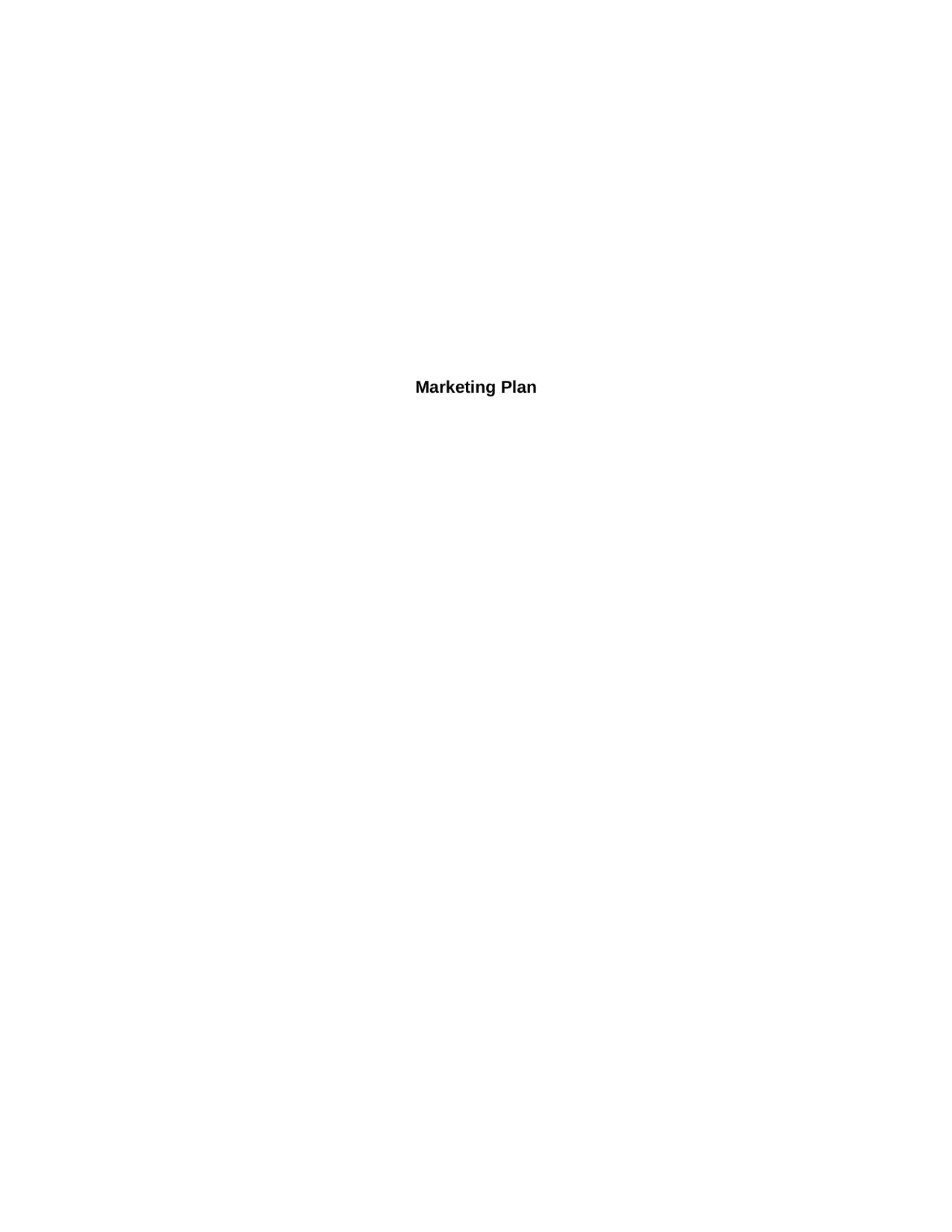
Marketing Plan
Paraphrase This Document
Need a fresh take? Get an instant paraphrase of this document with our AI Paraphraser
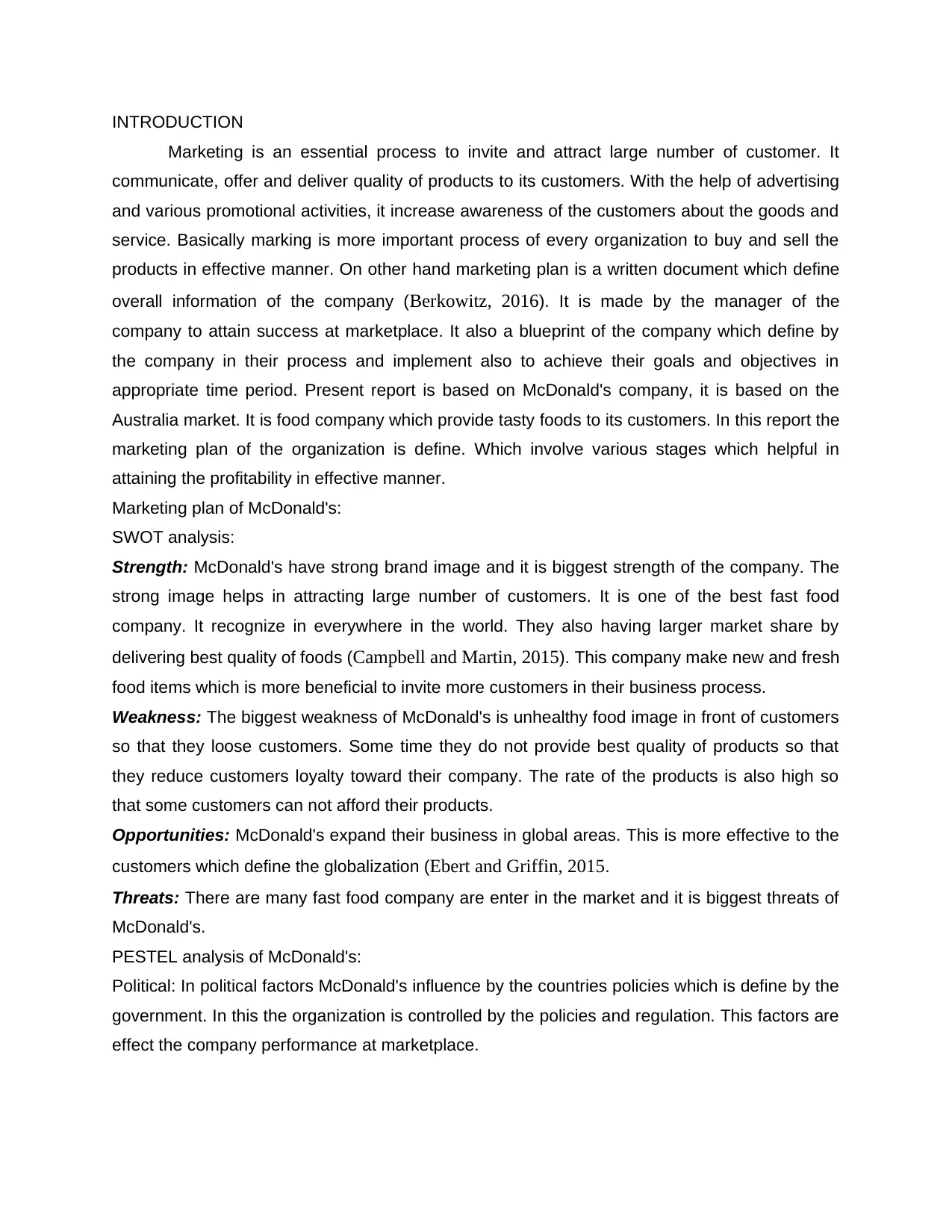
INTRODUCTION
Marketing is an essential process to invite and attract large number of customer. It
communicate, offer and deliver quality of products to its customers. With the help of advertising
and various promotional activities, it increase awareness of the customers about the goods and
service. Basically marking is more important process of every organization to buy and sell the
products in effective manner. On other hand marketing plan is a written document which define
overall information of the company (Berkowitz, 2016). It is made by the manager of the
company to attain success at marketplace. It also a blueprint of the company which define by
the company in their process and implement also to achieve their goals and objectives in
appropriate time period. Present report is based on McDonald's company, it is based on the
Australia market. It is food company which provide tasty foods to its customers. In this report the
marketing plan of the organization is define. Which involve various stages which helpful in
attaining the profitability in effective manner.
Marketing plan of McDonald's:
SWOT analysis:
Strength: McDonald's have strong brand image and it is biggest strength of the company. The
strong image helps in attracting large number of customers. It is one of the best fast food
company. It recognize in everywhere in the world. They also having larger market share by
delivering best quality of foods (Campbell and Martin, 2015). This company make new and fresh
food items which is more beneficial to invite more customers in their business process.
Weakness: The biggest weakness of McDonald's is unhealthy food image in front of customers
so that they loose customers. Some time they do not provide best quality of products so that
they reduce customers loyalty toward their company. The rate of the products is also high so
that some customers can not afford their products.
Opportunities: McDonald's expand their business in global areas. This is more effective to the
customers which define the globalization (Ebert and Griffin, 2015.
Threats: There are many fast food company are enter in the market and it is biggest threats of
McDonald's.
PESTEL analysis of McDonald's:
Political: In political factors McDonald's influence by the countries policies which is define by the
government. In this the organization is controlled by the policies and regulation. This factors are
effect the company performance at marketplace.
Marketing is an essential process to invite and attract large number of customer. It
communicate, offer and deliver quality of products to its customers. With the help of advertising
and various promotional activities, it increase awareness of the customers about the goods and
service. Basically marking is more important process of every organization to buy and sell the
products in effective manner. On other hand marketing plan is a written document which define
overall information of the company (Berkowitz, 2016). It is made by the manager of the
company to attain success at marketplace. It also a blueprint of the company which define by
the company in their process and implement also to achieve their goals and objectives in
appropriate time period. Present report is based on McDonald's company, it is based on the
Australia market. It is food company which provide tasty foods to its customers. In this report the
marketing plan of the organization is define. Which involve various stages which helpful in
attaining the profitability in effective manner.
Marketing plan of McDonald's:
SWOT analysis:
Strength: McDonald's have strong brand image and it is biggest strength of the company. The
strong image helps in attracting large number of customers. It is one of the best fast food
company. It recognize in everywhere in the world. They also having larger market share by
delivering best quality of foods (Campbell and Martin, 2015). This company make new and fresh
food items which is more beneficial to invite more customers in their business process.
Weakness: The biggest weakness of McDonald's is unhealthy food image in front of customers
so that they loose customers. Some time they do not provide best quality of products so that
they reduce customers loyalty toward their company. The rate of the products is also high so
that some customers can not afford their products.
Opportunities: McDonald's expand their business in global areas. This is more effective to the
customers which define the globalization (Ebert and Griffin, 2015.
Threats: There are many fast food company are enter in the market and it is biggest threats of
McDonald's.
PESTEL analysis of McDonald's:
Political: In political factors McDonald's influence by the countries policies which is define by the
government. In this the organization is controlled by the policies and regulation. This factors are
effect the company performance at marketplace.
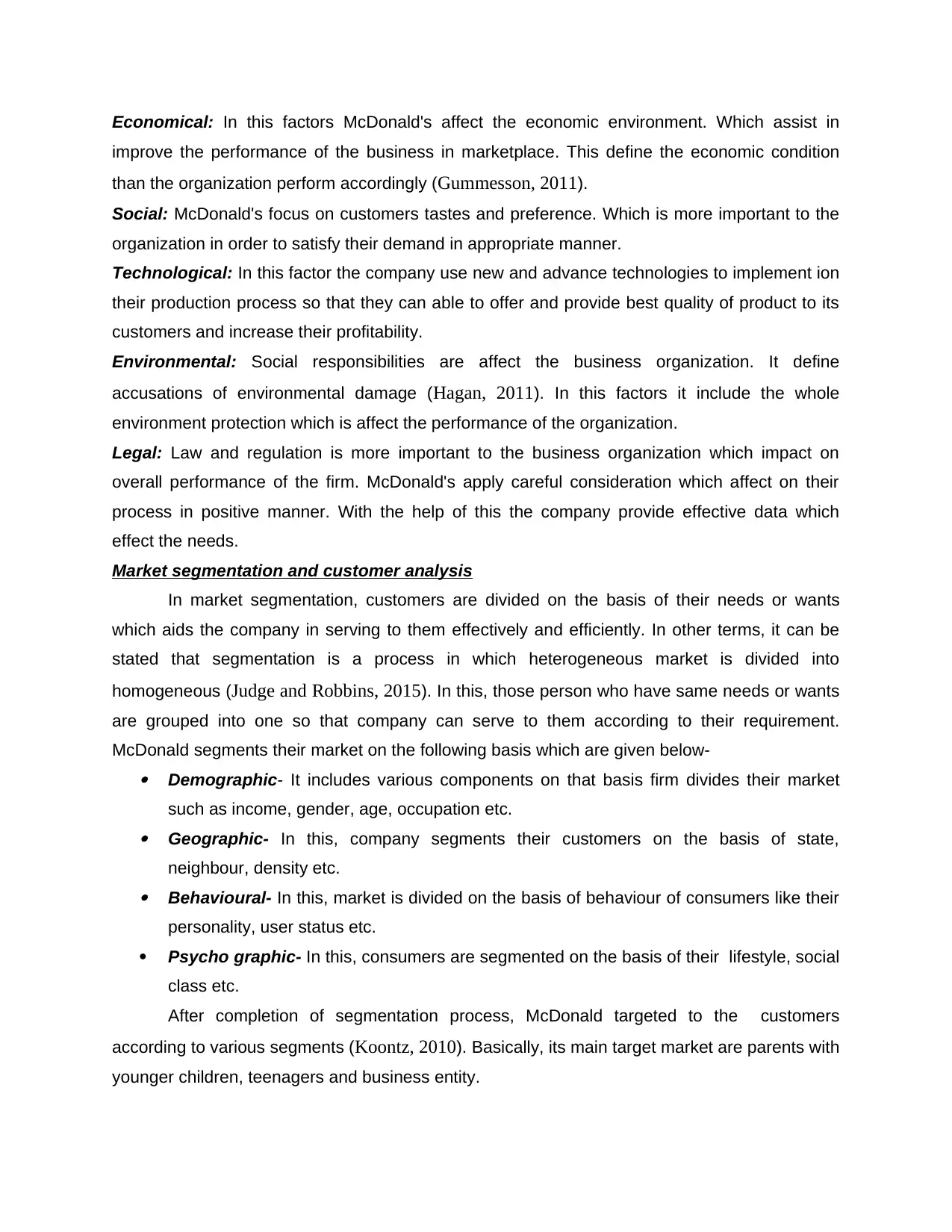
Economical: In this factors McDonald's affect the economic environment. Which assist in
improve the performance of the business in marketplace. This define the economic condition
than the organization perform accordingly (Gummesson, 2011).
Social: McDonald's focus on customers tastes and preference. Which is more important to the
organization in order to satisfy their demand in appropriate manner.
Technological: In this factor the company use new and advance technologies to implement ion
their production process so that they can able to offer and provide best quality of product to its
customers and increase their profitability.
Environmental: Social responsibilities are affect the business organization. It define
accusations of environmental damage (Hagan, 2011). In this factors it include the whole
environment protection which is affect the performance of the organization.
Legal: Law and regulation is more important to the business organization which impact on
overall performance of the firm. McDonald's apply careful consideration which affect on their
process in positive manner. With the help of this the company provide effective data which
effect the needs.
Market segmentation and customer analysis
In market segmentation, customers are divided on the basis of their needs or wants
which aids the company in serving to them effectively and efficiently. In other terms, it can be
stated that segmentation is a process in which heterogeneous market is divided into
homogeneous (Judge and Robbins, 2015). In this, those person who have same needs or wants
are grouped into one so that company can serve to them according to their requirement.
McDonald segments their market on the following basis which are given below- Demographic- It includes various components on that basis firm divides their market
such as income, gender, age, occupation etc. Geographic- In this, company segments their customers on the basis of state,
neighbour, density etc. Behavioural- In this, market is divided on the basis of behaviour of consumers like their
personality, user status etc.
Psycho graphic- In this, consumers are segmented on the basis of their lifestyle, social
class etc.
After completion of segmentation process, McDonald targeted to the customers
according to various segments (Koontz, 2010). Basically, its main target market are parents with
younger children, teenagers and business entity.
improve the performance of the business in marketplace. This define the economic condition
than the organization perform accordingly (Gummesson, 2011).
Social: McDonald's focus on customers tastes and preference. Which is more important to the
organization in order to satisfy their demand in appropriate manner.
Technological: In this factor the company use new and advance technologies to implement ion
their production process so that they can able to offer and provide best quality of product to its
customers and increase their profitability.
Environmental: Social responsibilities are affect the business organization. It define
accusations of environmental damage (Hagan, 2011). In this factors it include the whole
environment protection which is affect the performance of the organization.
Legal: Law and regulation is more important to the business organization which impact on
overall performance of the firm. McDonald's apply careful consideration which affect on their
process in positive manner. With the help of this the company provide effective data which
effect the needs.
Market segmentation and customer analysis
In market segmentation, customers are divided on the basis of their needs or wants
which aids the company in serving to them effectively and efficiently. In other terms, it can be
stated that segmentation is a process in which heterogeneous market is divided into
homogeneous (Judge and Robbins, 2015). In this, those person who have same needs or wants
are grouped into one so that company can serve to them according to their requirement.
McDonald segments their market on the following basis which are given below- Demographic- It includes various components on that basis firm divides their market
such as income, gender, age, occupation etc. Geographic- In this, company segments their customers on the basis of state,
neighbour, density etc. Behavioural- In this, market is divided on the basis of behaviour of consumers like their
personality, user status etc.
Psycho graphic- In this, consumers are segmented on the basis of their lifestyle, social
class etc.
After completion of segmentation process, McDonald targeted to the customers
according to various segments (Koontz, 2010). Basically, its main target market are parents with
younger children, teenagers and business entity.
⊘ This is a preview!⊘
Do you want full access?
Subscribe today to unlock all pages.

Trusted by 1+ million students worldwide
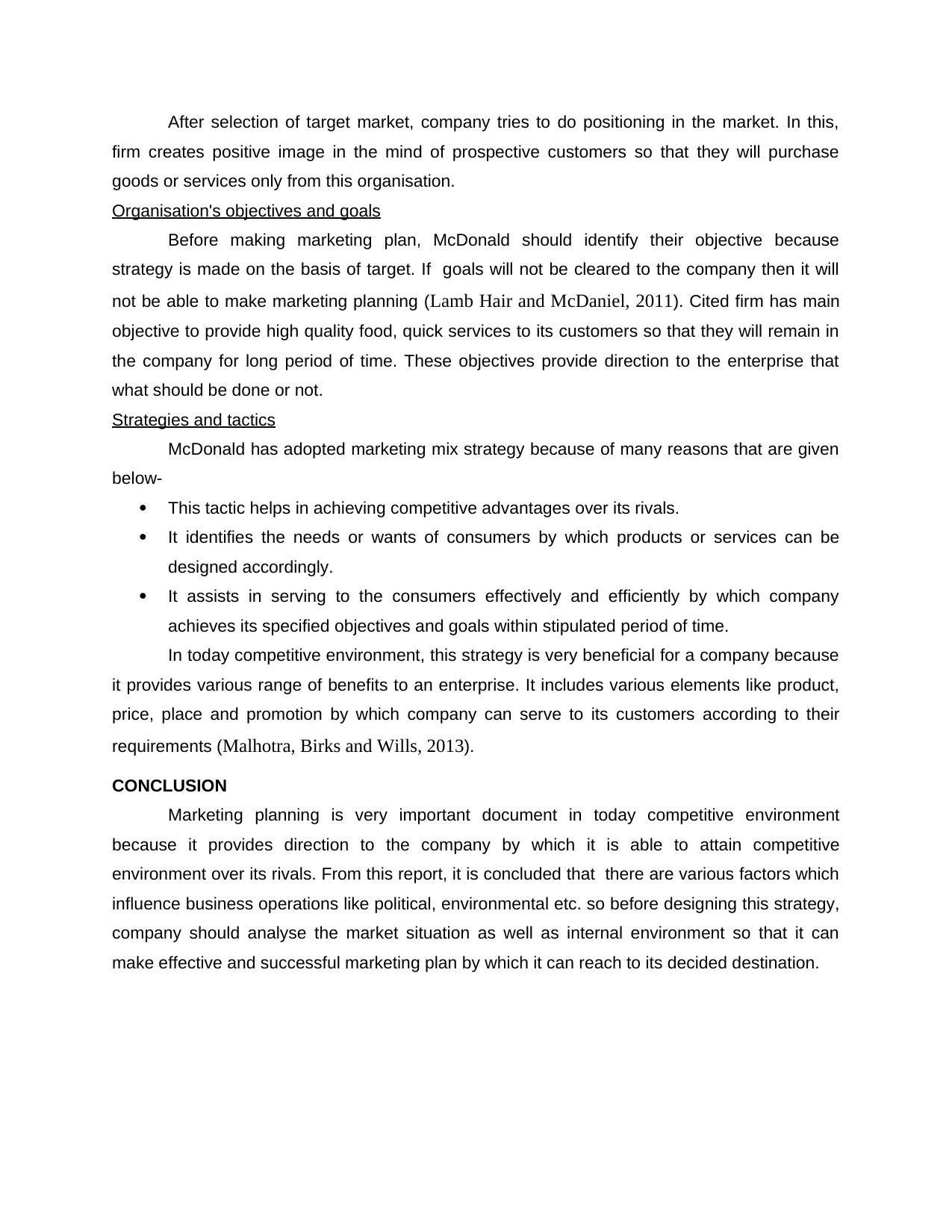
After selection of target market, company tries to do positioning in the market. In this,
firm creates positive image in the mind of prospective customers so that they will purchase
goods or services only from this organisation.
Organisation's objectives and goals
Before making marketing plan, McDonald should identify their objective because
strategy is made on the basis of target. If goals will not be cleared to the company then it will
not be able to make marketing planning (Lamb Hair and McDaniel, 2011). Cited firm has main
objective to provide high quality food, quick services to its customers so that they will remain in
the company for long period of time. These objectives provide direction to the enterprise that
what should be done or not.
Strategies and tactics
McDonald has adopted marketing mix strategy because of many reasons that are given
below-
This tactic helps in achieving competitive advantages over its rivals.
It identifies the needs or wants of consumers by which products or services can be
designed accordingly.
It assists in serving to the consumers effectively and efficiently by which company
achieves its specified objectives and goals within stipulated period of time.
In today competitive environment, this strategy is very beneficial for a company because
it provides various range of benefits to an enterprise. It includes various elements like product,
price, place and promotion by which company can serve to its customers according to their
requirements (Malhotra, Birks and Wills, 2013).
CONCLUSION
Marketing planning is very important document in today competitive environment
because it provides direction to the company by which it is able to attain competitive
environment over its rivals. From this report, it is concluded that there are various factors which
influence business operations like political, environmental etc. so before designing this strategy,
company should analyse the market situation as well as internal environment so that it can
make effective and successful marketing plan by which it can reach to its decided destination.
firm creates positive image in the mind of prospective customers so that they will purchase
goods or services only from this organisation.
Organisation's objectives and goals
Before making marketing plan, McDonald should identify their objective because
strategy is made on the basis of target. If goals will not be cleared to the company then it will
not be able to make marketing planning (Lamb Hair and McDaniel, 2011). Cited firm has main
objective to provide high quality food, quick services to its customers so that they will remain in
the company for long period of time. These objectives provide direction to the enterprise that
what should be done or not.
Strategies and tactics
McDonald has adopted marketing mix strategy because of many reasons that are given
below-
This tactic helps in achieving competitive advantages over its rivals.
It identifies the needs or wants of consumers by which products or services can be
designed accordingly.
It assists in serving to the consumers effectively and efficiently by which company
achieves its specified objectives and goals within stipulated period of time.
In today competitive environment, this strategy is very beneficial for a company because
it provides various range of benefits to an enterprise. It includes various elements like product,
price, place and promotion by which company can serve to its customers according to their
requirements (Malhotra, Birks and Wills, 2013).
CONCLUSION
Marketing planning is very important document in today competitive environment
because it provides direction to the company by which it is able to attain competitive
environment over its rivals. From this report, it is concluded that there are various factors which
influence business operations like political, environmental etc. so before designing this strategy,
company should analyse the market situation as well as internal environment so that it can
make effective and successful marketing plan by which it can reach to its decided destination.
Paraphrase This Document
Need a fresh take? Get an instant paraphrase of this document with our AI Paraphraser
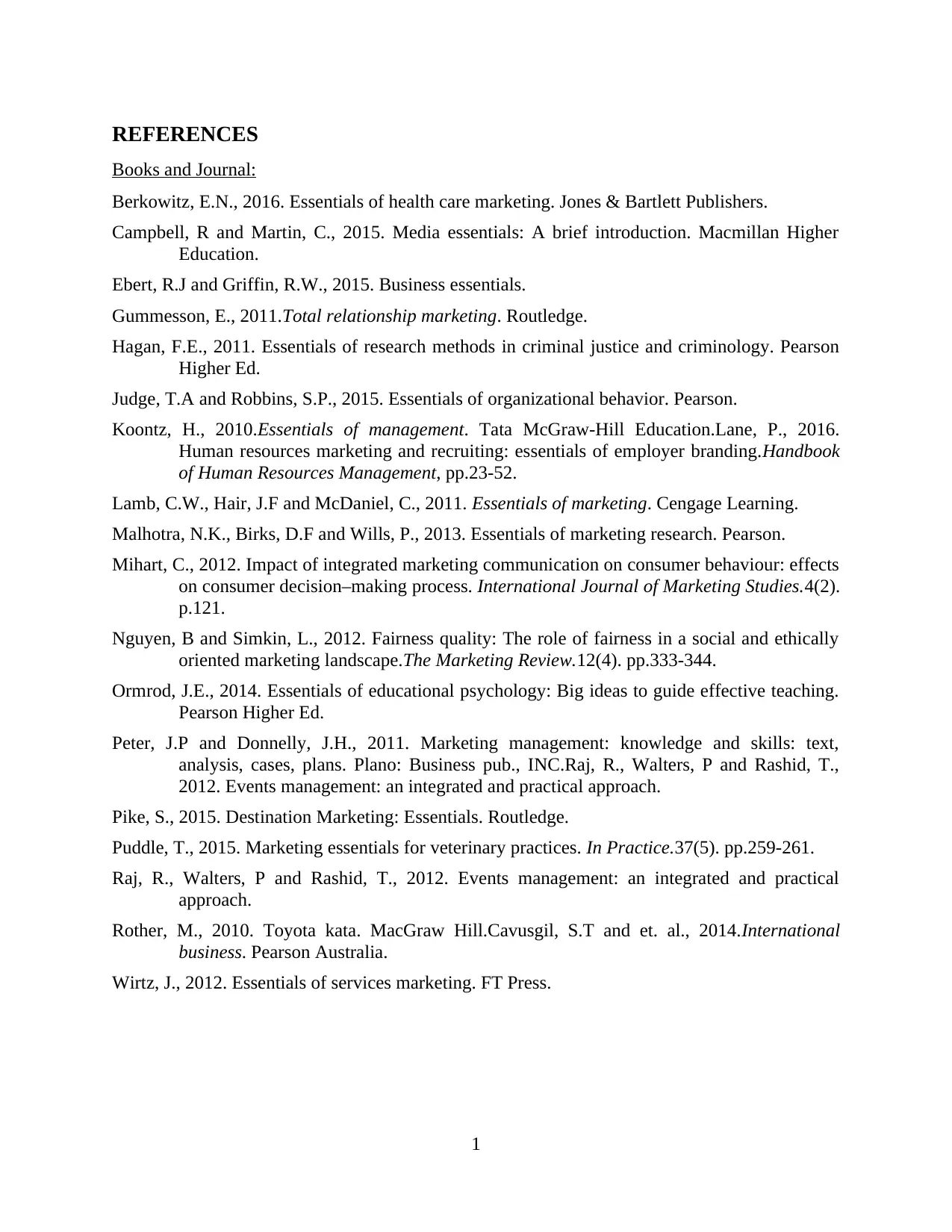
REFERENCES
Books and Journal:
Berkowitz, E.N., 2016. Essentials of health care marketing. Jones & Bartlett Publishers.
Campbell, R and Martin, C., 2015. Media essentials: A brief introduction. Macmillan Higher
Education.
Ebert, R.J and Griffin, R.W., 2015. Business essentials.
Gummesson, E., 2011.Total relationship marketing. Routledge.
Hagan, F.E., 2011. Essentials of research methods in criminal justice and criminology. Pearson
Higher Ed.
Judge, T.A and Robbins, S.P., 2015. Essentials of organizational behavior. Pearson.
Koontz, H., 2010.Essentials of management. Tata McGraw-Hill Education.Lane, P., 2016.
Human resources marketing and recruiting: essentials of employer branding.Handbook
of Human Resources Management, pp.23-52.
Lamb, C.W., Hair, J.F and McDaniel, C., 2011. Essentials of marketing. Cengage Learning.
Malhotra, N.K., Birks, D.F and Wills, P., 2013. Essentials of marketing research. Pearson.
Mihart, C., 2012. Impact of integrated marketing communication on consumer behaviour: effects
on consumer decision–making process. International Journal of Marketing Studies.4(2).
p.121.
Nguyen, B and Simkin, L., 2012. Fairness quality: The role of fairness in a social and ethically
oriented marketing landscape.The Marketing Review.12(4). pp.333-344.
Ormrod, J.E., 2014. Essentials of educational psychology: Big ideas to guide effective teaching.
Pearson Higher Ed.
Peter, J.P and Donnelly, J.H., 2011. Marketing management: knowledge and skills: text,
analysis, cases, plans. Plano: Business pub., INC.Raj, R., Walters, P and Rashid, T.,
2012. Events management: an integrated and practical approach.
Pike, S., 2015. Destination Marketing: Essentials. Routledge.
Puddle, T., 2015. Marketing essentials for veterinary practices. In Practice.37(5). pp.259-261.
Raj, R., Walters, P and Rashid, T., 2012. Events management: an integrated and practical
approach.
Rother, M., 2010. Toyota kata. MacGraw Hill.Cavusgil, S.T and et. al., 2014.International
business. Pearson Australia.
Wirtz, J., 2012. Essentials of services marketing. FT Press.
1
Books and Journal:
Berkowitz, E.N., 2016. Essentials of health care marketing. Jones & Bartlett Publishers.
Campbell, R and Martin, C., 2015. Media essentials: A brief introduction. Macmillan Higher
Education.
Ebert, R.J and Griffin, R.W., 2015. Business essentials.
Gummesson, E., 2011.Total relationship marketing. Routledge.
Hagan, F.E., 2011. Essentials of research methods in criminal justice and criminology. Pearson
Higher Ed.
Judge, T.A and Robbins, S.P., 2015. Essentials of organizational behavior. Pearson.
Koontz, H., 2010.Essentials of management. Tata McGraw-Hill Education.Lane, P., 2016.
Human resources marketing and recruiting: essentials of employer branding.Handbook
of Human Resources Management, pp.23-52.
Lamb, C.W., Hair, J.F and McDaniel, C., 2011. Essentials of marketing. Cengage Learning.
Malhotra, N.K., Birks, D.F and Wills, P., 2013. Essentials of marketing research. Pearson.
Mihart, C., 2012. Impact of integrated marketing communication on consumer behaviour: effects
on consumer decision–making process. International Journal of Marketing Studies.4(2).
p.121.
Nguyen, B and Simkin, L., 2012. Fairness quality: The role of fairness in a social and ethically
oriented marketing landscape.The Marketing Review.12(4). pp.333-344.
Ormrod, J.E., 2014. Essentials of educational psychology: Big ideas to guide effective teaching.
Pearson Higher Ed.
Peter, J.P and Donnelly, J.H., 2011. Marketing management: knowledge and skills: text,
analysis, cases, plans. Plano: Business pub., INC.Raj, R., Walters, P and Rashid, T.,
2012. Events management: an integrated and practical approach.
Pike, S., 2015. Destination Marketing: Essentials. Routledge.
Puddle, T., 2015. Marketing essentials for veterinary practices. In Practice.37(5). pp.259-261.
Raj, R., Walters, P and Rashid, T., 2012. Events management: an integrated and practical
approach.
Rother, M., 2010. Toyota kata. MacGraw Hill.Cavusgil, S.T and et. al., 2014.International
business. Pearson Australia.
Wirtz, J., 2012. Essentials of services marketing. FT Press.
1

2
⊘ This is a preview!⊘
Do you want full access?
Subscribe today to unlock all pages.

Trusted by 1+ million students worldwide
1 out of 6
Related Documents
Your All-in-One AI-Powered Toolkit for Academic Success.
+13062052269
info@desklib.com
Available 24*7 on WhatsApp / Email
![[object Object]](/_next/static/media/star-bottom.7253800d.svg)
Unlock your academic potential
Copyright © 2020–2025 A2Z Services. All Rights Reserved. Developed and managed by ZUCOL.





